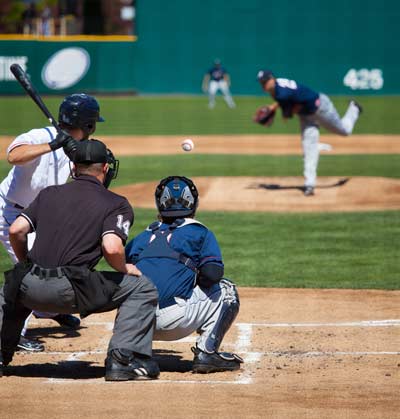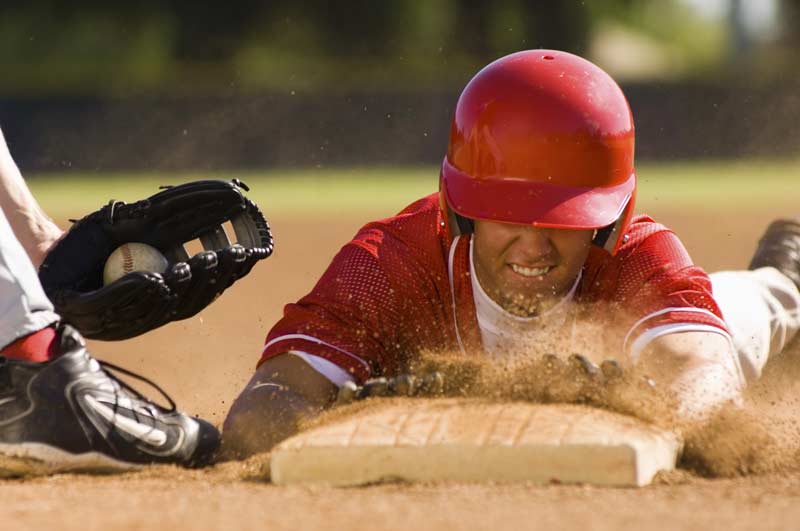
By Carl Valle
There is an epidemic failure within the game to understand what is really happening. And this leads people who run Major League Baseball teams to misjudge their players and mismanage their teams. – Peter Brand, Moneyball
Two Texas baseball clubs, the Houston Astros and Texas Rangers, researched running speed and other performance factors in the success of players. The findings were very important for strength and conditioning coaches as it affirms the need for speed and how talented athletes, not just skilled ones, are important draft picks. Unfortunately some rather questionable data was also presented from one of the studies regarding the actual speed of players running 10 yards, as it looks like that either a big chunk of MLB players are running world record speeds or timing methods again becomes a discussion point just like the NFL Combine. Even if the data has some problems, the general consensus is that power is a priority and speed to first base or to the ball in play, is an important factor to the success of winning.

How Speed Influences Baseball Performance
Baseball is crudely summarized as one team trying to score runs and the other preventing it. At the end of 9 innings, if the score is not tied, who has the highest runs wins. While this is not new, it’s important to note that scoring runs is not just hitting a ball or pitching a ball, it’s sometimes hitting a ball and running or catching a ball after being hit. With the rise of speed in baseball pitching, we are actually seeing a decline in several speed elements because of the Steroid Era hangover. If baseball is going to evolve it will have to start looking at some of the ways to ensure athletes are durable so they can start making marginal but impactful improvements in player speed in both development (minor leagues) and major league performance. Some writers have talked about sport science and what variables are important with speed and if Sir Isaac Newton was still alive he would have a few problems with the conjectures. The most important factor in training speed is to compare where you are and where you need to be, and of course what ways will support your “path” there.
The Differences between Tactical and Performance Variables
Many nuances exists with the game of baseball that are so subtle that they are an entire discussion itself, but it’s important to note them and to differentiate between tactical factors versus performance ability. Tactical is knowing the game, and performance is about being able to express it physiologically and biomechanically. What is disappointing is that it’s nearly 2014 and we still have problems with timing, as professional journals are allowing stopwatch data compiled by people in a dugout and published data that may be indicating that Usain Bolt’s speed is commonplace in the MLB. The exciting thing is that the data is not useless, as precision and accuracy issues are easily addressed with interoperation and logical conclusions can be made from it. From the two studies from the NSCA, we can conclude that gross power and acceleration is the cornerstone to baseball performance, and the question now is how to develop speed based qualities that improve the player’s chances of winning for his ball club.
The Science to Getting to first Base
Besides hitting a home run, getting walked, or getting hit, a player has a change to reach first base safely if his hit manages to buy enough time for him to successfully run to the bag without being thrown out. A lot of factors will interact with getting to the bag first, besides the extrinsic abilities of fielders getting to the ball, something one can’t control, and the location of the ball hit, one has to run as fast as possible to get on base or extra bases. Game situations will dictate the likelihood of approaches, as nobody hits a home run each at bat and recruiting track sprinters who are curve runners to bunt for inside the park home runs is not possible. What one can change is the ability to express speed from training, sometimes through indirect methods such as weight lifting, an area that is more likely to help baseball at the higher levels rather than teaching and training speed in the minors. In the study Pure acceleration is the primary determinant of speed to first-base in major-league baseball game situations by Coleman and Amonette, the two authors concluded that the first half of the 90 foot base path (27.4m) was highly indicative of successfully getting on first, and they called this segment (home plate to foul line) pure acceleration. The 15 yards or 13.7 meters is the same distance from the starting line to the first barrier in the men’s 110m hurdles, and due to the longer and richer history of information from hurdle, track and field again can help give some wisdom to team sports. Pure acceleration should be replied with early acceleration, since terminal acceleration is the point what an athlete can no longer increase his or her speed. Instead of using a convenient checkpoint because of field dimensions, one should rethink the distance and process since trainable changes are the most important and those areas should be measured. Like mentioned earlier, the physiological and biomechanical factors are influential to the results of getting to first faster. How one is able to train those two areas in a MLB schedule is a different story, but since most players are not required to play those amounts of games, more scheduling freedom allows for better development.

How Fast are MLB players?
Gross acceleration, be it in the form of a catcher defending against an infield hit , an outfielder catching a long fly, or a quick base stealer trying to get to second base after pinch running, general abilities to overcome inertia and reach a specific peak velocity is the name of the game. The shorter the distance overcoming inertia becomes more important, the longer the distance maximal speed and late acceleration qualities improve. One should be balanced enough to have good late acceleration to reach home from scoring position but should have excellent early acceleration get going on line drive or getting out of the batter’s box and rushing a fielder. The sport is a mind game as well when performance measures increases the skill demand of tactical considerations, and improvements will make routine plays a problem when pressure is applied. Universal baseball speed is standing acceleration, not in a three point start like the NFL combine, and that quality of accelerating from a realistic stance in baseball was tested by the Texas Rangers. The study had a few specific limitations that should have been addressed, since timing systems, regardless of equipment, usually make point A to point B the definition of how an athlete is assessed. In the study, the authors state the following:
“Speed was determined by a timed 10-yard (9-m) sprint. Sprint times were measured using an infrared testing device (Speed Trap II; Brower Timing Systems, Draper, UT, USA) as performed on an Astroturf field. Timing began on the subject’s movement out of a 2-point (base-running) stance. The best of 3 attempts was recorded as the subject’s best time.”
As a track coach with experience using over a dozen timing systems this a big problem. I have no problem with using the subjects best time but it would be interested to see all of the data. Does an athlete need a few repetitions to get going? Will we see more on deck jumps to activate muscles or will weighted bats continue to be the norm? Second how were the timing systems used specifically to get first movement? Anyone watching baseball knows that a base running stance is not straight ahead as the athlete may need to go laterally to ensure they are not picked off or tagged. This makes momentum a factor and should not be compared to straight ahead sprinting, but one must be careful to look at the end times. 10 yards is about 9 meters, and as we know with all-time first movement 10m segments from sprinters departing from blocks who specialize in linear speed from competition, it seems that some MLB players are consistently beating Usain Bolt and other greats. It’s likely that the ten yards was actually timed and measured properly, but the time is not how fast one is going 0-10 yards with first movement, more like first detected motion via body part crossing the beam. Like bobsleigh timing, this makes sport comparison nearly impossible as calculations are too rough for precise evaluation, but we know from other sports and the other data it’s likely that coaches need to be careful when explaining the results. I would say first step versus first movement, even if foot contact is not made as it is closer to what his happening even if the term is a misnomer. What is interesting is to see the data from the Texas Ranger’s study and the average of time of 1.52 in the 10 yard dash. Also shared was that some athletes were faster and of course slower than that time by a Standard Deviation of a tenth of a second, making some athletes in the 1.4 range according to the study. I would not accept those times as running times and suggest that athletes use their own timing options to gage the starting point of where they are and improve those times. Since many equipment differences and approaches to measuring speed exist, it’s important to compare apples to apples and not convert something perhaps not easily replicated. What is also interesting is that a similar study Effect of age on anthropometric and physical performance measures in professional baseball players with MLB players and lower levels such as college and minor leagues had only 1.62 sprint times with players from the Mets, Tigers, Rangers, and Reds. The conclusion though is that no matter what system is used to assist in measuring speed, it simply needs to be done according to the Houston study.
“This suggests that pure acceleration may be the most important performance attribute to improve to increase game-specific speed. As such, coaches should implement training programs to improve pure acceleration. Moreover, coaches should consider strategies to motivate maximal effort acceleration from the batter’s box, such as routinely timing sprint speed in game situations.” – Journal of Strength and Conditioning Research
Should baseball players train differently for Speed?
The earlier article A Review of Al Vermeil Techniques for a Faster 40 yard dash showed some very useful methods in improving the functional baseball speed of athletes as well as some options in improving later acceleration. Two important ideas emerge here with developing speed, the ability to perform and the need to reduce injuries. While much of the time improvement in baseball speed is the first 15 yards, the need to be fast at all distances is important. Some longer upright and pole running in the past is questioned, but the amount of pulling from rounding the bases with upright postures may suggest that all elimination of top speed or similar running should still be touched upon from time to time.
Some differences in modalities such as the Olympic lifts may be problematic for some players, specifically the pitching group, but much of the training should be in strength training and specific sled work. The sleds offer a near instant improvement in technique and doesn’t require much time to learn. Baseball is played nearly year round and training or athletic development is limited because of culture and time. Baseball is an old game and isn’t going to change quickly, from the baseball research it’s clear that it’s important to develop some speed.
In conclusion, no player is going to outrun the “white rat” as good fielding will be faster than any athlete running, but speed does matter when plays are in the possible time ranges when a play is longer than a quick out. Developing speed by addressing realistic options based on both the culture and schedule of baseball gives a player and his team better probabilities in winning.
Please share this article so others may benefit.
[mashshare]

